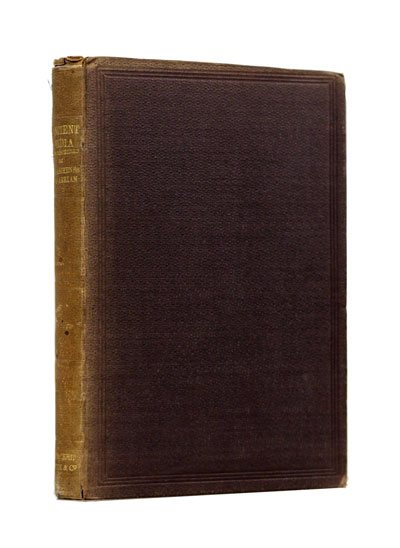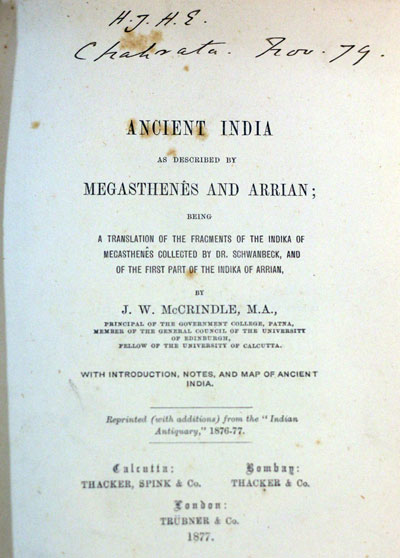The first English translation of two of the most important works of Greek-Indian interaction from the ancient world. Extremely rare now. Without a doubt the single most important outside window into ancient India.
From wikipedia:
About Megasthenes:
Megasthenes (Ancient Greek: Μεγασθένης, c. 350 – c. 290 BC) was an ancient Greek historian, diplomat and Indian ethnographer and explorer in the Hellenistic period, author of the work Indika. He was born in Asia Minor and became an ambassador of Seleucus I Nicator of the Seleucid dynasty possibly to Chandragupta Maurya in Pataliputra, India. However the exact date of his embassy is uncertain. Scholars place it before 298 BCE, the date of Chandragupta’s death.
About Arrian:
Arrian of Nicomedia (c. 86/89 – c. after 146/160 AD; Latin: Lucius Flavius Arrianus, possibly Lucius Flavius Arrianus Xenophon; Greek Ἀρριανός Arrianos) was a Greek historian, public servant, military commander and philosopher of the Roman period.
The Anabasis of Alexander by Arrian is considered the best source on the campaigns of Alexander the Great. However, more recently even though modern scholars have generally preferred Arrian to other extant primary sources this attitude towards Arrian is beginning to change in the light of studies into Arrian’s method.
About Megasthenes’s Indika:
Indika (Greek: Ἰνδικά; Latin: Indica) is an account of Mauryan India by Megasthenes. The original book is now lost, but its fragments have survived in later Greek and Latin works. The earliest of these works are those by Diodorus Siculus, Strabo (Geographica), Pliny, and Arrian (Indica).
According to the text reconstructed by J. W. McCrindle, Megasthenes’ Indica describes India as follows:
Geography
India is a quadrilateral-shaped country, bounded by the ocean on the southern and the eastern side. The Indus river forms the western and the north-western boundary of the country, as far as the ocean. India’s northern border reaches the extremities of Tauros. From Ariana to the Eastern Sea, it is bound by mountains that are called Kaukasos by the Macedonians. The various native names for these mountains include Parapamisos, Hemodos and Himaos (the Himalayas). Beyond Hemodos, lies Scythia inhabited by the Scythians known as Sakai. Besides Scythia, the countries of Bactria and Ariana bordered India.
At the extreme point of India, the gnomon of the sundial often casts no shadow, and the Ursa Major is invisible at night. In the remotest parts, the shadows fall southward, and even Arcturus is not visible.
India has many large and navigable rivers, which arise in the mountains on its northern border. Many of these rivers merge into Ganges, which was 30 stadia wide at its source, and runs from north to south. The Ganges empties into the ocean that forms the eastern boundary of Gangaridai. Other nations feared Gangaridai’s huge force of the biggest elephants, and therefore, Gangaridai had never been conquered by any foreign king. Indus also runs from north to south, and had several navigable tributaries. The most notable tributaries are Hupanis, the Hudaspes, and the Akesines. One peculiar river is Sillas, which originates from a fountain of the same name. Everything cast into this river sinks down to the bottom – nothing floats in it. In addition, there are a large number of other rivers, supplying abundant water for agriculture. According to the native philosophers and natural scientists, the reason for this is that the bordering countries are more elevated than India, so their waters run down to India, resulting in such a large number of rivers.
History
Pataliputra capital, showing Greek and Persian influence, early Mauryan Empire period, 4th-3rd century BC.
In the primitive times, the Indians lived on fruits and wore clothes made of animal skin, just like the Greeks. The most learned Indian scholars say that Dionysus invaded India, and taught Indians several things including how to grow plants, make wine and worship. He founded several large cities, introduced laws and established courts. For this reason, he was regarded as a deity by the Indians. He ruled entire India for 52 years, before dying of old age. His descendants ruled India for several generations, before being dethroned and replaced with democratic city-states.
The Indians who inhabit the hill country also claim that Herakles was one of them. Like the Greeks, they characterize him with the club and the lion’s skin. According to them, Herakles was a powerful man who subjugated evil beasts. He had several sons and one daughter, who became rulers in different parts of his dominion. He founded several cities, the greatest of which was Palibothra (Pataliputra). Herakles built several places in this city, fortified it with water-filled trenches and settled a number of people in the city. His descendants ruled India for several generations, but never launched an expedition beyond India. After several years, the royal rule was replaced by democratic city states, although there existed a few kings at the time Alexander’s invasion of India.
Flora and fauna
India has several mountains with fruit trees of every kind. There are a large number of animal species in India. The Indian elephants are far stronger than the Libyan elephants, because of the abundance of food on the Indian soil. The elephants are domesticated in large numbers, and trained for war. The gestation period of the elephants ranges from 16 to 18 months, and the oldest of the elephants live up to 200 years.
Economy
Gold, silver, copper and iron are abundant on Indian soil. Besides tin and other metals are used for making a number of tools, weapons, ornaments, and other articles.
India has very fertile plains, and irrigation is practised widely. The main crops include rice, millet, a crop called bosporum, other cereals, pulses and other food plants. There are two crop cycles per year, since rain falls in both summer and winter. At the time of summer solstice, rice, millet, bosporum and sesamum are sown. During winter, wheat is sown.
No famines have ever occurred in India because of the following reasons:
- The Indians are always assured of at least one of the two seasonal crops
- There are a number of spontaneously growing fruits and edible roots available.
- The Indian warriors regard those engaged in agriculture and animal husbandry as sacred. Unlike the warriors in other countries, they do not ravage farms during war conquests. Moreover, the warring sides never destroy the enemy land with fire or cut down its trees.
Society
Because of its large size, India is inhabited by many diverse races, all of which are indigenous. India has no foreign colony, and Indians have not established any colonies outside India. The Indians are of above average stature, because of abundant food, fine water and pure air. They are well-skilled in art.
A law, prescribed by ancient Indian philosophers, bans slavery. The law treats everyone equally, but allows the property to be unevenly distributed.
The population of India is divided into 7 endogamous and hereditary castes:
Philosophers
Farmers
Herders
Artisans
Military
Overseers
Councillors and Assessors
Administration
The foreigners are treated well. Special officers are appointed to ensure that no foreigner was harmed, and judges handed out harsh punishment to those who took unfair advantage of the foreigners. Sick foreigners are attended by physicians and taken care of. Foreigners who died in India are buried, and their property is delivered to their relatives.
Historical reliability
Later writers such as Arrian, Strabo, Diodorus, and Pliny refer to Indika in their works. Of these writers, Arrian speaks most highly of Megasthenes, while Strabo and Pliny treat him with less respect.
The first century Greek writer Strabo called both Megasthenes and his succeeding ambassador Deimachus liars, and stated that “no faith whatever” could be placed in their writings. The Indika itself contained numerous fantastical stories of people with backwards feet, ears large enough to sleep in, no mouths, or other strange features. Strabo directly contradicted these descriptions, assuring his readers that Megasthenes’ stories, along with his recounting of India’s founding by Hercules and Dionysus, were mythical with little to no basis in reality.
According to Paul J. Kosmin, Indica depicts contemporary India as an unconquerable territory, in order to justify Seleucus’s retreat from India. Megasthenes tries to argue that Dionysus was able to conquer India, because before his invasion, India was a primitive rural society. Dionysus’ urbanization of India makes India a powerful, impregnable nation. The later ruler — the Indian Herakles — is presented as a native of India, despite similarities with the Greek Heracles. This, according to Kosmin, is because now India is shown as unconquerable. Megasthenes emphasizes that no foreign army had been able to conquer India (since Dionysus) and Indians had not invaded a foreign country either. This representation of India as an isolated, invincible country is an attempt to vindicate Seleucus’ peace treaty with the Indian emperor.
Legacy
Megasthenes’ Indica, along with Ctesias’ book of the same name, is among the earliest well-known Western accounts of India and he is regarded as one of the founders of the study of Indian history in the West. He is also the first foreign Ambassador to be mentioned in Indian history.
Megasthenes also comments on the presence of pre-Socratic views among the Brahmans and Jews.
About Arrian’s Indika:
Indica (Greek: Ἰνδική Indike) is the name of a short military history about interior Asia, particularly Indian subcontinent, written by Arrian in 2nd-century CE. The subject of the book covers the expedition of Alexander the Great that occurred between 336 and 323 BCE, about 450 years before Arrian. The book mainly tells the story of Alexander’s officer Nearchus’ voyage from India to the Persian Gulf after Alexander the Great’s conquest of the Indus Valley. However, much of the importance of the work comes from Arrian’s in depth asides describing the history, geography, and culture of the ancient Indian subcontinent. Arrian wrote his Indica in the Ionic dialect, taking Herodotus for his literary mode.
Arrian was born in 86 CE, did not visit Indian subcontinent, and the book is based on a variety of legends and texts known to Arrian, such as the Indica by Megasthenes. Arrian also wrote a companion text Anabasis. Of all ancient Greek records available about Alexander and interior Asia, Arrian’s texts are considered most authoritative.
The Indica provides the historian a good idea of how the Greeks and Romans saw India. Though, as stated above, everything in Indica is not completely factual in its details, it is useful to know what the Greeks and Romans thought of India and how they may have viewed it. Some descriptions about Indian people from the Indica:
- “The southern Indians resemble the Ethiopians a good deal, and, are black of countenance, and their hair black also, only they are not as snub-nosed or so woolly-haired as the Ethiopians; but the northern Indians are most like the Egyptians in appearance.”
- “No Indian ever went outside his own country on a warlike expedition, so righteous were they.”
- “Indians do not put up memorials to the dead; but they regard their virtues as sufficient memorials for the departed, and the songs which they sing at their funerals.”
- “This also is remarkable in India, that all Indians are free, and no Indian at all is a slave. In this the Indians agree with the Lacedaemonians. Yet the Lacedaemonians have Helots for slaves, who perform the duties of slaves; but the Indians have no slaves at all, much less is any Indian a slave.”
- “The Indians generally are divided into seven castes, the wise men, farmers, herdsmen, artisans and shopkeepers, soldiers, overlookers, and government officials including army and navy officers.”
- “The Indians in shape are thin and tall and much lighter in movement than the rest of mankind.”




